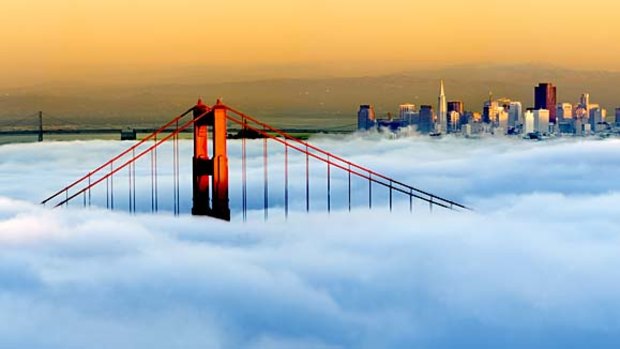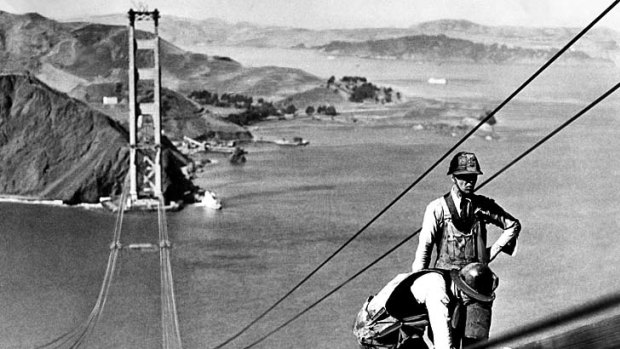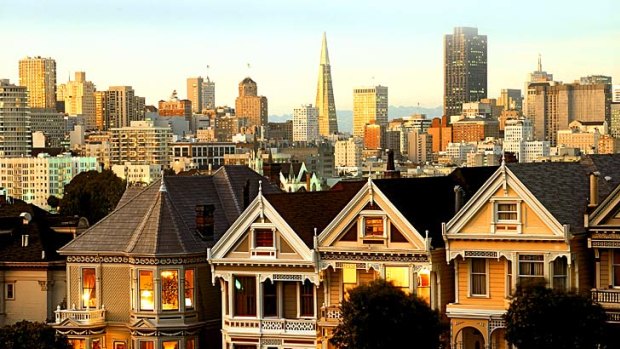
View of the fog rising over the Golden Gate Bridge.Credit: Getty Images
San Francisco's Golden Gate Bridge is 75 and, as Lance Richardson finds, its beauty hasn't faded with age.
The hue is orange vermillion - officially, international orange - an unmistakable rust colour that shines in sunlight and cleaves the San Francisco fog like super-heated iron through snow. If the US Navy had its way, the entire thing would be yellow and black, the better to alert ship captains (if the ferry companies had their way, it wouldn't have been built at all). But thanks to the efforts of people such as the chief engineer, Joseph Strauss, and the architect who chose a colour inspired by the surrounding Californian landscape, Irving Morrow, the Golden Gate Bridge is as integral a part of San Francisco's character as Victorian houses, film noir and vertigo-inducing hills that only the very determined would have ever thought appropriate for settlement.
The bridge turns 75 on May 27. It remains an engineering marvel, a symbol of American ingenuity and persuasive evidence that beauty doesn't fade with age - particularly if you have a maintenance crew working around the clock.
The idea of connecting San Francisco with Marin County across the Golden Gate Strait was raised as early as the mid-19th century, when Joshua Norton, a local eccentric who declared himself "Emperor of the United States" and "Protector of Mexico", released an "imperial decree" instructing the general population to build bridges from the peninsula. To put things in perspective, Norton also ordered the dissolution of Congress and outlawed the nickname "Frisco", which he found "abominable". It wasn't until decades later, in 1916, that a bridge became a serious civic proposal, with Strauss putting forward an affordable cantilever-suspension design that was deemed "practical" by engineers and "ugly" by everybody else. In conceptual drawings it looks like two rat traps set on the edges of the bay.
The design so celebrated today, with its soaring towers and graceful suspension cables, emerged later still, as the team led by Strauss surmounted tremendous technical difficulties after breaking ground in 1933, during the Great Depression. The Golden Gate Strait is 120 metres deep in places; to lay foundations, workers were forced to dynamite the bottom while wearing enormous metal helmets with extended oxygen hoses. Scuba diving was a distant dream. Furthermore, the tower closest to the San Francisco side required an artificial island to be built in roiling currents. The navy, based on the Presidio - now a national park where the bridge connects to the city - hated the intrusion on their space. Not to mention the workers, dangling on ropes, who sometimes fell into a heart-stopping net suspended above the water. The day the net broke, giving way beneath some wayward framework, 10 men plummeted to their deaths.
The bridge cost $US35 million dollars - a similar project would be $2 billion to $3 billion in today's economy - and took four years to build, culminating in an elaborate opening ceremony on May 27, 1937.

The Golden Gate bridge, in the San Francisco Bay, during its construction in October, 1935.Credit: AFP
The 75th anniversary is equally elaborate, spanning the San Francisco waterfront from Fort Point to Pier 39 in Fisherman's Wharf. A Golden Gate Festival on May 26-27 features photography exhibitions, art installations, a lunch for people who attended the original opening and a circus big top at Crissy Fields.
But what makes the anniversary particularly noteworthy is that this is merely the midpoint of a celebration spanning much of the year - 75 "tributes" around the Bay Area, many continuing into September, mean travellers can mark the milestone as well. The American Institute of Architects, for example, is displaying postcard views of the bridge and greater San Francisco area from August; the California Historical Society features a dedicated exhibition of photographs and artefacts; and the Walt Disney Family Museum, nearby in the Presidio, is screening a six-month film series of the bridge as represented by Hollywood.
Even more lasting is the contribution by the Golden Gate National Parks Conservancy. Until recently, visitors to the south end of the bridge found a small viewing platform and a poorly stocked gift shop.

Victorian houses set against San Francisco's skyline.Credit: AFP
"The policy used to be that we're running a roadway, not Disneyland," says Mary Currie, the bridge's public affairs director and a published historian, as we stand near a garden with "75" rendered in orange flowers. David Shaw, of the Parks Conservancy, joins us and we wander through a site so new that workers scramble around applying finishing touches.
The small viewing platform has been extended into an overlook, with sweeping views directly down the roadway beneath the cables. The art deco Bridge Cafe now features local, sustainably grown food. A Roundhouse, once home to tourist kitsch, now acts as the starting point for a selection of interpretive tours. A new Bridge Pavilion, striking in International Orange, is filled with tasteful merchandise and an original model tower, built in 1933 at Princeton University to test the suspension design. About the only thing missing, at least on this occasion, is the bridge itself - on any given day ocean fog turns visibility into a coin toss.
Overwhelmingly, the focus is on enhancing the bridge's history, design, and location for a visitor. Shaw is quick to point out a new walking trail snaking beneath the overlook that connects with other paths, including the 800-kilometre Bay Area Trail, which crosses the Golden Gate Strait to Marin County. "The bridge is actually the centrepiece of a national park," he says. "It's one of the largest in an urban area in the world."
Indeed, there's perhaps no better way to appreciate the bridge than to walk its span, taking in details such as the art deco towers that decrease in size the higher they go, creating an illusion of even greater reach.
It has often been said that the structure is unique in enhancing its surrounding environment through colour and form. That it exerts a sublime pull is undeniable. Kim Novak, playing an entranced Madeleine, throws herself into the waters beneath the bridge in Alfred Hitchcock's Vertigo; more than 1300 people have thrown themselves into the bay for real, awarding the bridge the dubious record of having the most suicides from a man-made structure anywhere.
More positively, its symbolic potency extends to notions of freedom and promise. "A lot of people go through the bridge as part of the immigrant experience," Shaw says. "For Chinese-Americans" - a prominent part of San Francisco's population - "I've heard it's called the 'golden door,' where you look at America as a place of opportunity." Not for nothing is its east-coast equivalent sometimes pegged as the Statue of Liberty.
So beloved is the Golden Gate Bridge that in 1987, the last major anniversary preceding this one, pedestrians crowded onto the roadway in such numbers that its convex curve flattened to a straight line.
Security concerns mean that could never happen today. But, though we live in a very different world now, the bridge is also an icon of continuity. The form of celebration might change; the conviction that it's something worth celebrating is as strong as ever.
Lance Richardson travelled courtesy of San Francisco Travel and United Airlines.
FAST FACTS
Getting there
United Airlines has a fare to San Francisco from Sydney (13hr 17min non-stop) and Melbourne for about $1575 low-season return including tax. Melbourne passengers transit in Sydney; see united.com. Australians must apply for travel authorisation at least 72 hours before departure at https://esta.cbp.dhs.gov.
Staying there
Nob Hill was once home to San Francisco's four railroad barons, and the Huntington Hotel remains a classic emblem of San Francisco style, with apartment-size guest rooms and a celebrated restaurant, Big 4. Rooms cost from $US410 ($402) a night; see huntingtonhotel.com.
The newest hotel in San Francisco is also one of the closest to the bridge. Inn at the Presidio, in the historic Pershing Hall and embracing a philosophy of "green and local", melds Presidio memorabilia with contemporary furnishings that make the most of the natural setting. Rooms cost from $US195 a night; see innatthepresidio.com.
Celebrating there
A schedule of anniversary events, partner tributes and site improvements is at goldengatebridge75.org.
Interpretative tours, including night tours, can be booked online and cost $US12.95 an adult and $US9.95 child/pensioner (day tour) and $US21.95/$US18.95 (night tour at 8.15pm); see goldengatebridgetour.org.
An exhibition dedicated to the bridge at the California Historical Society runs until October 14. See californiahistoricalsociety.org.
The bay trail crosses the Golden Gate Bridge on an 800-kilometre route in the area. Sectional maps and recommended routes are at www.baytrail.org.
More information
Sign up for the Traveller Deals newsletter
Get exclusive travel deals delivered straight to your inbox. Sign up now.